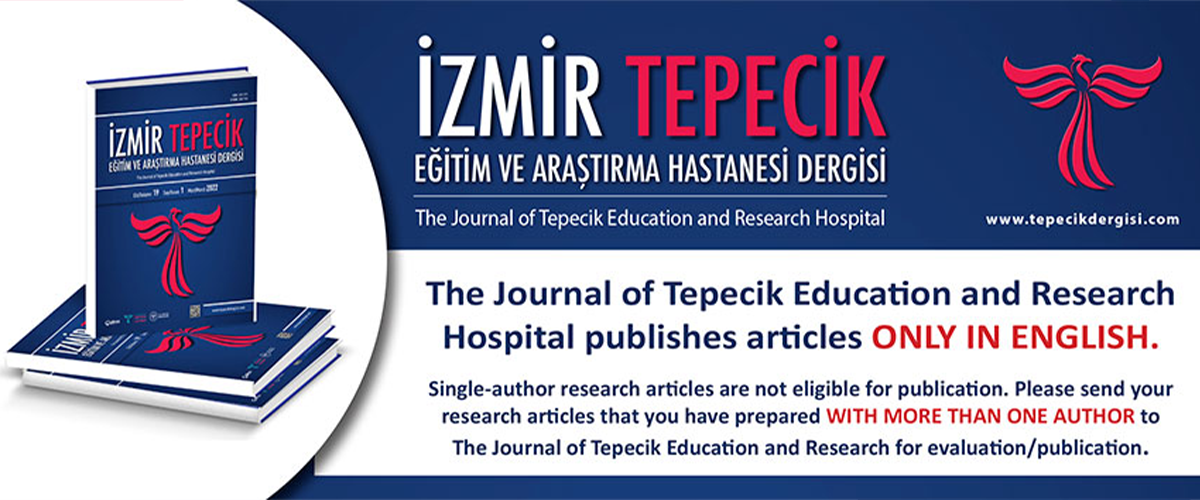








Comparison of Mechanical Thrombectomy Outcomes Before and During COVID-19 Pandemic
Ahmet Ergin Çapar1, Gözde Sercan Bıtrak2, Demet Funda Baş2, Orkun Sarıoğlu1, Kebire Eylül Arslan2, Görkem Atasoy1, Şükran Köse3, Ufuk Şener2, Ümit Belet11University of Health Sciences Turkey, İzmir Tepecik Education and Research Hospital, Clinic of Radiology, İzmir, Turkey2University of Health Sciences Turkey, İzmir Tepecik Education and Research Hospital, Clinic of Neurology, İzmir, Turkey
3University of Health Sciences Turkey, İzmir Tepecik Education and Research Hospital, Clinic of Infectious Diseases, İzmir, Turkey
Objective: To evaluate the reflection of the pandemic on the management of acute stroke mechanical thrombectomy (MT).
Methods: We retrospectively evaluated 100 acute ischemic stroke patients between March 1, 2019-Februray 29, 2020, and between March 1, 2020-March 1, 2021, who underwent (MT) at our institute. Patients were divided into two groups as those who underwent thrombectomy before the Coronavirus disease-2019 (COVID-19) pandemic (group 1) and those who underwent thrombectomy during the period of COVID-19 pandemic (group 2). All the diagnosis of stroke patients was confirmed by magnetic resonance imaging and computed tomography. Demographics, clinical and laboratory data were recorded. The SPSS version 26.0 was used for statistical analysis.
Results: A total of 100 patients, 50 before and 50 after the pandemic, were included in the study. No statistically significant difference was observed between the groups in terms of demographic data and risk factors. The time from symptom onset to groin puncture was significantly longer during the pandemic period than before (p=0.001). No significant difference was observed in the time from groin puncture to recanalization (p=0.251), recanalization rates (p=0.806) and the number of passes (p=0.889). There was no difference between the pre-pandemic and post-pandemic groups in terms of the frequency of intracranial hemorrhage (p=0.501), complication (p=0.153) and decompression (p=0.538) after thrombectomy. The modified Rankin scores scores at 3 months were similar (p=0.316).
Conclusion: As a result, the time from symptom to procedure is prolonged in acute ischemic stroke patients who underwent MT in our center during the pandemic period. In the respect of procedural findings and outcomes of thrombectomy before and during pandemic, there had been no significant change at our center.
COVID-19 Pandemi Öncesi ve Sırasında Mekanik Trombektomi Sonuçlarının Karşılaştırılması
Ahmet Ergin Çapar1, Gözde Sercan Bıtrak2, Demet Funda Baş2, Orkun Sarıoğlu1, Kebire Eylül Arslan2, Görkem Atasoy1, Şükran Köse3, Ufuk Şener2, Ümit Belet11University of Health Sciences Turkey, İzmir Tepecik Education and Research Hospital, Clinic of Radiology, İzmir, Turkey2University of Health Sciences Turkey, İzmir Tepecik Education and Research Hospital, Clinic of Neurology, İzmir, Turkey
3University of Health Sciences Turkey, İzmir Tepecik Education and Research Hospital, Clinic of Infectious Diseases, İzmir, Turkey
Amaç: Pandeminin akut inmede mekanik trombektomi (MT) yönetimi üzerindeki yansımasını değerlendirmektir.
Yöntem: Kliniğimizde MT uygulanan 100 akut iskemik inme hastası retrospektif olarak değerlendirildi. Hastalar, Koronavirüs hastalığı-2019 (COVID-19) pandemisinden önce trombektomi geçirenler (grup 1, 1 Mart 2019-29 Şubat 2020) ve COVID-19 pandemi döneminde trombektomi geçirenler (grup 2, 1 Mart 2020-1 Mart 2021) olmak üzere iki gruba ayrıldı. İnme tanıları manyetik rezonans görüntüleme ve bilgisayarlı tomografi ile doğrulandı. Demografik, klinik ve laboratuvar verileri kaydedildi. İstatistiksel analiz için SPSS sürüm 26,0 kullanıldı.
Bulgular: Çalışmaya her biri 50 hastadan oluşan toplam 100 hasta dahil edildi. Demografik veriler ve risk faktörleri açısından gruplar arasında istatistiksel olarak anlamlı bir fark gözlenmedi. Ancak, semptom başlangıcından kasık ponksiyonuna kadar geçen süre pandemi döneminde önemli ölçüde daha uzundu (p=0,001). Kasık ponksiyonundan yeniden kan akışının sağlanmasına kadar geçen süre (p=0,251), yeniden kan akışının sağlanma oranları (p=0,806) ve geçiş sayıları (p=0,889) açısından anlamlı bir fark gözlenmedi. Ek olarak, pandemi öncesi ve sonrası gruplar arasında intrakraniyal kanama sıklığı (p=0,501), komplikasyonlar (p=0,153) ve trombektomi sonrası dekompresyon (p=0,538) açısından fark yoktu. Üç ay sonraki modifiye Rankin skorları da iki grup arasında benzerdi (p=0,316).
Sonuç: Pandemi döneminde MT uygulanan akut iskemik inme hastalarında semptom başlangıcından işlemin gerçekleştirilmesine kadar geçen süre uzamıştır. Ancak, merkezimizde pandemi öncesi ve sonrası trombektomi prosedürel bulguları ve sonuçları açısından önemli bir değişiklik olmamıştır.
Manuscript Language: English
(92 downloaded)




